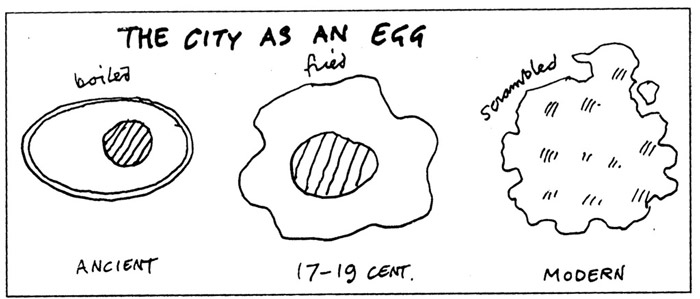Hole in the Clouds
May 29, 2012

The machine that's demolishing Mt. Olive AME Church in the neighborhood is something you can rent in New Jersey. The jaws at the business end of the thing are heavy-duty grapples; you rent a regular excavating machine on caterpillar treads, remove its digging bucket, and pin on the grapple. The two-tined jaw opens and closes against the stationary three-tined jaw, which is reinforced, as seen here, with a rod called, appropriately enough, a stiff arm.
The cultural and economic forces that are demolishing Mt. Olive AME Church and a whole host of other churches in the neighborhood are something else again. These church buildings, many of them built from stone like this one, have sat here for a hundred years or so, sometimes changing denominations as the nearby population changed. The latest wave of immigrants to the neighborhood doesn't seem very churched at all, and so the old buildings get put on the market. Developers snatch them up and tear them down for a chance to build several new houses at once, in a part of the city that's already densely built. New houses--row houses--sell readily here to people who want to walk to work and/or to stores and restaurants. The new residents evidently are not interested in walking to church.
Soon, the excavator and its grapple will be loaded on a truck to go back to the heavy equipment lot in New Jersey, and we'll see five three-story row houses rise up on this lot, with squared-off bay windows and ten-year tax exemptions.
demolition
Philadelphia
work
neighborhood
church
heavy machinery
history
demographic change
Mt. Olive AME Church
Oct 2, 2012

eggs
history
infographic
cities
(Image credit: Cedric Price)
Jul 8, 2013
 Philadelphia history is conveniently compressed: Benjamin Franklin flew a kite, then all those guys rang the liberty bell, and then Rocky Balboa ran up the steps of the art museum.
Philadelphia history is conveniently compressed: Benjamin Franklin flew a kite, then all those guys rang the liberty bell, and then Rocky Balboa ran up the steps of the art museum.
Today, Franklin is easier to find on an oatmeal box than on the city streets, and the liberty bell is cracked and silent. But Rocky? The fighter who never was, except, of course, in the movies? He's big and bronze and easy to find, right by the foot of the museum steps.
Tourists from all over the world seek him out daily, eager to pose for pictures with fists raised triumphantly, just like his. This group included my brother-in-law and his sons, visiting from Israel.
After their moment with the statue, the tourists run up the steps, just the way Sylvester Stallone did in the movies. But you may recall that when Rocky "really" was training for that first fight and running all over town, it was wintertime. He wore a hoodie and sweatpants, and we could see his breath.
This past Fourth of July weekend, the Rocky wannabes among the tourists–and they were legion, as always–were in shirtsleeves, if not shirtless. The sun was unforgiving, and the air was almost too thick and heavy to breathe.
But straight up the 72 steps everybody went, as their friends held up cellphones to record the moment. Entire tour buses emptied out to run up the steps. Children ran up with their grandparents. Dogs ran up with their people. Cyclists ran up with their bikes in their arms. Earbuds or no earbuds, everybody had "Gonna Fly Now" in their heads.
Search for "Rocky steps" on YouTube, and you'll find 86,500 results. Here's a nice short one in Spanish, viewed by more than a quarter of a million people.
The crazy part, of course, is that Rocky isn't real. People all over the world say his story in the movie is inspirational, proving somehow that even a nobody, just another bum from the neighborhood, can beat the best.
"I will do the stairs on my 50. birthday, december 2013," wrote one of the inspired people. "From germany just for one day. It's crazy, but it's a dream since 30 years. In all of us there is a rocky...."
At the top of the steps, some people feel ready to take on the world. Some of them propose marriage. Some of them go on into the museum, eventually. All of them turn around at the top and look out over the city, just like Rocky, and raise their arms high and then . . . probably they start thinking about cheesesteaks.
cityscape
Sandy Fuchs
Philadelphia
statue
tourists
bronze
history
movie
Martin Fuchs
Philadelphia Museum of Art
Rocky Steps
Josh Fuchs
Rocky
Mar 11, 2014
 Back in March 1866, Greymouth was a rough little gold rush town on New Zealand's wild west coast, crowded with young men scheming to get rich quick, many of them immigrants from Ireland. While most of the town celebrated St. Patrick's Day that year, a man named Synder Browne huddled in a tent near the muddy outskirts of town, setting type by hand for the first edition of Greymouth's second newspaper, the Evening Star.
Back in March 1866, Greymouth was a rough little gold rush town on New Zealand's wild west coast, crowded with young men scheming to get rich quick, many of them immigrants from Ireland. While most of the town celebrated St. Patrick's Day that year, a man named Synder Browne huddled in a tent near the muddy outskirts of town, setting type by hand for the first edition of Greymouth's second newspaper, the Evening Star.
Greymouth's first paper, already a year old by then, was the Grey River Argus, which would become a Socialist tabloid. For the next century, the left-wing Argus and the right-wing Star would duke it out in the local marketplace of public opinion; their editors, it was said, took opposing positions on absolutely every public issue. Only once a year, on Christmas Eve, would the two editors get together for a holiday drink and some collegial conversation. Every other day of the year they spat and fussed in the competition for readers and for influence over Greymouth's affairs.
The town survived the gold rush, thanks to another mineral that had actually been discovered earlier but was initially ignored because it didn't glitter like you-know-what: coal. There was plenty of coal in the hillsides around Greymouth, though all the customers for coal, and all the ports suitable for coal shipping, were hundreds or thousands of kilometers away on the other side of the Southern Alps. Greymouth was a seaside town but without a decent harbor; it sat rough and damp in the nearly uninhabited rainforest along the west coast of New Zealand's South Island. To make a go of coal mining thereabouts, somebody was going to have to build a railroad over the mountains.
The Argus and the Star had different ideas about Greymouth's economic development. They argued for different people to pay for, and benefit from, the railroad project. When coal mining became established, the two papers argued even more fiercely over mine safety and environmental issues. The mines there have been productive but quite dangerous, with high concentrations of coalbed methane. Many miners have died over the years in mine fires and explosions, and several mine projects have been abandoned after methane levels proved uncontrollable. The Argus and the Star told different stories about the tragedies.
Most mines are closed now, and the town survives on forestry work and tourism; it is a portal to the glacier and fjord country further south. The population has leveled off at about 5,000, and there's only one newspaper left, the Greymouth Star. The Argus folded in the 1960s.
Today, the Star is owned by a publishing conglomerate based in Dunedin. And even though print media is in big trouble all over the world, the Star is hanging on, with subscribers all along the west coast and a workforce of more than 60 fulltime employees.
The Star is available online as well as on paper. In the latest edition, you can read about Charles Edward Miller Pearce, a New Zealand–born mathematician who taught at Adelaide University in Australia. He came home for a visit, rented a car at the Hokitika airport, just south of Greymouth, then drove south on the coastal highway until he apparently lost consciousness. His car landed upside down in shallow water, with only his head submerged.
"If he had been conscious, all he would have had to do was turn his head towards the middle of the car," a witness told the coroner, according to the Star's report, "and his face would have been out of the water."
"I observed that he had a peaceful expression on his face," noted a second witness. "My guess was that he fell asleep at the wheel and never woke up."
New Zealand
mining
work
history
gold
Greymouth
coal
printing press
newspaper
(Image credit: Little Fuji)
Jul 21, 2014

At the north end of Castlepoint sheep station is Castle Rock itself, noted and named in the eighteenth century by Captain Cook. The rock anchors one end of a limestone reef; on the headland at the other end is Castlepoint Lighthouse, built in 1913, originally fueled by oil but now wired into the grid and controlled from a switchboard in Wellington, a couple of hours away. Its light is visible 22 miles out at sea.
The postage stamp above dates from 1947. For almost a century beginning in the 1890s, the New Zealand government operated a life insurance company that had government franking privileges and printed its own stamps. Lighthouses were nineteenth-century symbols for insurance companies (as were big rocks, e.g., Mutual of Omaha). The government sold off its insurance operations in the 1980s, to a corporation doing business as Tower Life of Dunedin, New Zealand.
The reef at Castlepoint is not at all like the coral reefs growing placidly around tropical lagoons; geologically, it's a chunk of ancient seafloor millions of years old heaved up violently during seismic activity associated with the collision of the Pacific and Australian tectonic plates.
The limestone in the reef is richly fossiliferous, and directly underneath the lighthouse it's pocked with caves.
Inside the reef is a lagoon and a wide, hard-sand beach, crucial features in the development of a large sheep station here, back in the days before highways. Since the coast in this region has no natural harbors, sheepmen used to drive wagonloads of wool bales down the beach, to be loaded at water's edge into small boats that ventured out at high tide to meet up with cargo ships waiting offshore.
Today, shipping activity at Castlepoint is mostly recreational in nature, and the hard-packed beach now serves tractors and boat trailers. The blue tractor in the picture below is driverless and remote controlled from the boat, where the captain calls for it to push an empty trailer down into the surf and then pull the loaded trailer back up to high ground.
In the picture below, the tiny figure walking the beach near water's edge is my mother-in-law.

beach
sheep
New Zealand
geology
rock
Pacific Ocean
history
Wairarapa
lighthouse
(Image credit: Little Fuji [lower photo])





